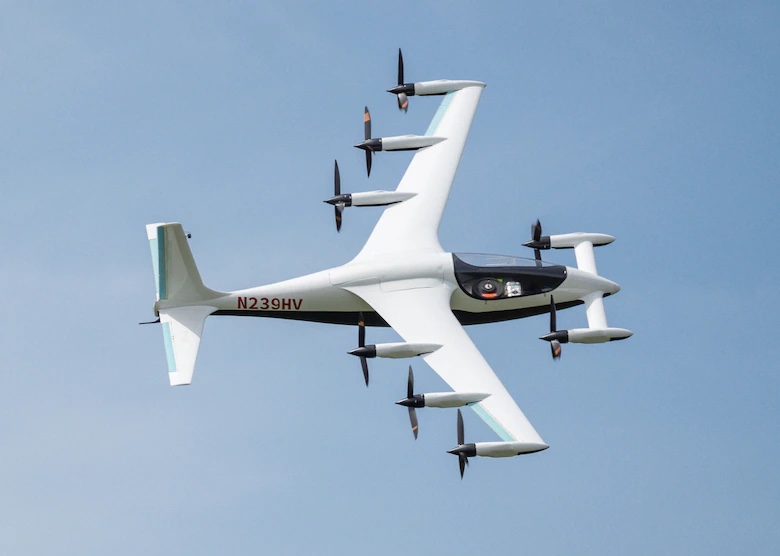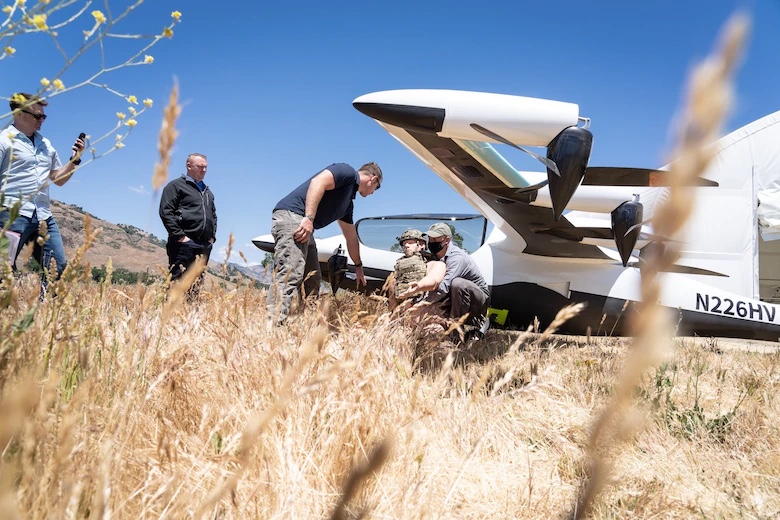WRIGHT-PATTERSON AIR FORCE BASE, Ohio (AFNS) —
AFWERX Agility Prime and new partner Kitty Hawk reached a milestone in May with their first operational exercise.

“This exercise produced important data that will bolster the program going forward,” said Lt. Col. Martin Salinas, the mission design team lead in the Air Force Operational Test and Evaluation Center.
The technology and companies in the AFWERX Agility Prime program continue to mature rapidly with a new partner Kitty Hawk joining the government/industry team. In the program’s first exercise, a diverse group of industry and government operators, engineers, and test professionals assessed the ability to do medical evacuation, personnel recovery, and logistics with Kitty Hawk’s Heaviside electric vertical takeoff and landing, or eVTOL, aircraft. The Kitty Hawk team also demonstrated Heaviside’s remote flying capabilities.
The multi-disciplinary team gathered a rich catalogue of data to inform dual-use utility at the prototype stage that will inform future developmental and fielding decisions. Besides assessing different loading scenarios, the team also observed demonstrations of remotely piloted and fully autonomous flights with Heaviside.

“The world is going to need new modes of transportation and Heaviside is one path to getting us there,” said Sebastian Thrun, Kitty Hawk CEO. “We are excited to be working with Agility Prime and look forward to our continued collaboration as we bring eVTOLs to more people.”
Founded in 2010 and based in California, Kitty Hawk, has developed numerous eVTOL vehicles including the Heaviside vehicle, named after the English engineer, Oliver Heaviside. Designed to be fast, small, quiet and green, the aircraft flies at up to 180 mph with a potential range of 100 miles plus reserves on a single charge, according to Kitty Hawk’s website. Heaviside takes off and lands in a 30×30 foot space, reaches sound levels of 38 dBA at 1,000 feet, is 100x quieter than a helicopter and requires less than half the energy per mile of a conventional electric car.
“The Agility Prime and Kitty Hawk teams facilitated the convergence of Air Force and Marine Corps testers and operators to engage with Heaviside, all while experimenting within the context of Personnel Recovery and logistics use-case scenarios,” Salinas said.
Salinas attributed the success of the California tests to the eagerness of those involved. “Pushing experimental tests in an operational context is challenging and exciting,” he said.
Col. Don Haley, Air Education and Training Command Detachment 62 commander, who leads a team in developing training syllabi for these new electric aircraft, noted, “this collaborative commercial/DoD use-case exploration revealed common attributes that serve both urban air mobility and search and rescue operations: High-reliability, responsive launch & recovery, minimal logistical footprint, accessibility for mobility-challenged, low acoustic signature, and high levels of autonomy.”
“We are pleased to welcome a new partner and happy about the progress in this first Agility Prime exercise,” said Col. Nathan Diller, AFWERX Director. “This is just the beginning of many examples that the team will be exploring in the coming months to partner with commercial companies in a way that accelerates maturity for commercialization, while providing the Department of the Air Force with decision-quality data for future force design.”
For more information, visit www.afresearchlab.com.
By Air Force Research Lab, AFWERX


In a word, “why?”. Please tell me how this is superior, or will be to today’s reliable, tested and improving platforms? Don’t divert and say it’s “green” or cavil at my statement. Explain what gap this fills, broad need it satisfies or how it adds, reliably, to something as important as a CSAR role.
I think the answer you are seeking is based in your assumption that the Air Force puts the same priority on CSAR as you do.
In case my comment has caused you any confusion, consider the HH-60W.
I think you’ve made the point quite succinctly about the Whiskey. I would only further state that we have people on the flight line who need more training, ditto some of the combat related MOS’ and other equipment needs that could be better met with this spend. You know rather than the latest “cool” stuff where some O-6 get visited by The Good Idea Fairy and then uses “green” to get the attention of his new DoD buddies.
While it’s definitely not there yet, and I’m not so much worried or convinced about “green” solutions, I think electric or more probably hybrid propulsion is a potential positive thing. Quiet modes of operation,potential for more damage resistance,increased range,, maybe stealthier designs ,and even performance enhancements are there to harvest in the long run. S92 definitely would have been an upgrade .
This! The greenwashing is only for congress to get it funded. Electrically driven aeroplanes certainly can have its uses and the tech may also be useful for improving small battery driven drones.